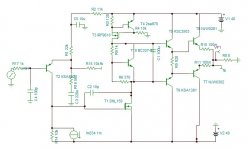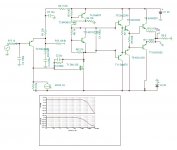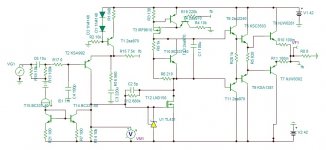What celebrates this amplifier is the depletion Mosfet LND150 (wrong on circuit). This component is an exception among transistors to have very linear transfer function at 5ma.
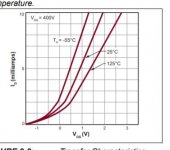
It has extraordinary high early with total 2.5pF on the drain, which makes it premium VAS transistor.
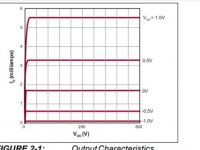
To keep low distortion and symmetrical saturation I used IRF9610 as CCS.
To get best sound of it I reduced the Blameless of Self to minimum, however the distortion at 1W is 0.004%. What makes this amp Audiophile not only it has dominant even order harmonics, it has OLBW of 36khz. The slew rate is 30V/us and can give undistorted full power to 130khz.
Of course it needs habitual accessories to be added.
Attachments
Last edited:
Nice to see a Fet used as VAS, happens not often.
This LND150 looks interesting and is very cheap. Would the circuit benefit even more if there were Fet drivers used instead of BJT’s, as the transconductance of the LND150 is very low?
Have you build the circuit?
This LND150 looks interesting and is very cheap. Would the circuit benefit even more if there were Fet drivers used instead of BJT’s, as the transconductance of the LND150 is very low?
Have you build the circuit?
I added some accessories, a ccs to adjust the offset and clean saturator which decreases the current of ccs at high output voltage. See the graph when the output approaches the 100w. The bias is 180ma to provide minimum distortion 0.00015% at 40w 1khz.
Attachments
Now that you have an EF3, R5 = 820R seems too high. This may give you shoot-through issues at high frequency / high power. I'd try anywhere from 300 to 430 ohms instead. This may also let you get away with a bit less output bias, 180 mA seems a tad on the toasty side.
LND150 seems like a promising part for VAS applications... too bad they don't make it in TO-126, but SOT-89 should do as well.
LND150 seems like a promising part for VAS applications... too bad they don't make it in TO-126, but SOT-89 should do as well.
"Blameless" is a word that does not belong to anyone, let alone Douglas Self.
He could have used a more particular name for one of his ideas if he wanted no one else to use it for whatever reason.
But "blameless"?
Is there a trademark?
Is "blameless" anyone's intellectual property?
Gimme a break.
He could have used a more particular name for one of his ideas if he wanted no one else to use it for whatever reason.
But "blameless"?
Is there a trademark?
Is "blameless" anyone's intellectual property?
Gimme a break.
Last edited:
Jan,
Is the Blameless name trade registered?
Actually I consider Hayk's design very simple and pretty good. I know that a mosfet works well as a VAS; we did it in the FetZilla and it was a hit.
Hugh
Is the Blameless name trade registered?
Actually I consider Hayk's design very simple and pretty good. I know that a mosfet works well as a VAS; we did it in the FetZilla and it was a hit.
Hugh
Well he did say 'To get best sound of it I reduced the Blameless of Self to minimum' so there is definitely a reference to that.
But it is no longer a Self Blameless, which has a specific definition coined by Doug.
Jan
But it is no longer a Self Blameless, which has a specific definition coined by Doug.
Jan
Last edited:
The schematics from #4 appears to be the 1st one that really works correctly and as expected. All the previous ones are lacking a DC path from the input transistor's base to ground, unless the preamp has no output capacitor and remains stable with an output offset of 0 mV. But what would happen if there's no preamp without output capacitor connected to the previous amplifiers?
Best regards!
Best regards!
Last edited:
By lack of spice model for LM334, I simulated it by a current mirror. The gate needed to be limited on slew rate saturation, so I added a 2.4 zener.
This I get with 1Mhz at PBW.
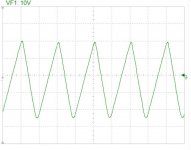
As one can see the positive slew rate is 90V/us and about 120V/us the negative.
Ian, I wanted to see what this exceptional depletion Mosfet can wield, so I took the Blameless circuit and replaced the VAS and it's emitter follower by the LND150. The more I simplified the better it worked. Of course it doesn't remain much to resemble the blameless with triple EF, but too late the title cannot be re-edited.
Attachments
i agree, "blameless" should be left alone with D. Self...
i am sure you guys can coin your own...
i am sure you guys can coin your own...
The output designed by LKA uses C3503/A1831 +470 ohm followed by C4793/A1837 +47 ohm driving triple output same pairs. It gives more phase margin but the distortion is 0.0008% instead of 0.00015%. I am thinking about it as now I increased the NFB my phase margin need to be considered but only on the positive slope.Now that you have an EF3, R5 = 820R seems too high. This may give you shoot-through issues at high frequency / high power. I'd try anywhere from 300 to 430 ohms instead. This may also let you get away with a bit less output bias, 180 mA seems a tad on the toasty side.
LND150 seems like a promising part for VAS applications... too bad they don't make it in TO-126, but SOT-89 should do as well.
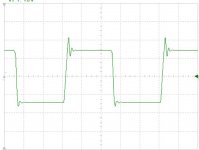
100khz
Of course it doesn't remain much to resemble the blameless with triple EF, but too late the title cannot be re-edited.
You as thread starter can always edit post # 1.
Jan
Not the title, only a moderator can do.You as thread starter can always edit post # 1.
Jan
I saw only yesterday this transistor also used as CCS. here ECL84 as differential push pull driveri have used the LND150 as CCS element, so seeing this as a VAS gives me ideas...
there is a to-220 IXYS depletion mosfets available, for more muscle, two of those, one on top for CCS duty with two resistors, and the other for the VAS would seem to me make a serious VAS stage...IXTP01N100D - Standard Series - N Channel Depletion Mode Discrete MOSFETs - Littelfuse
- Home
- Amplifiers
- Solid State
- Blameless Audiophile 75W amplifier.
